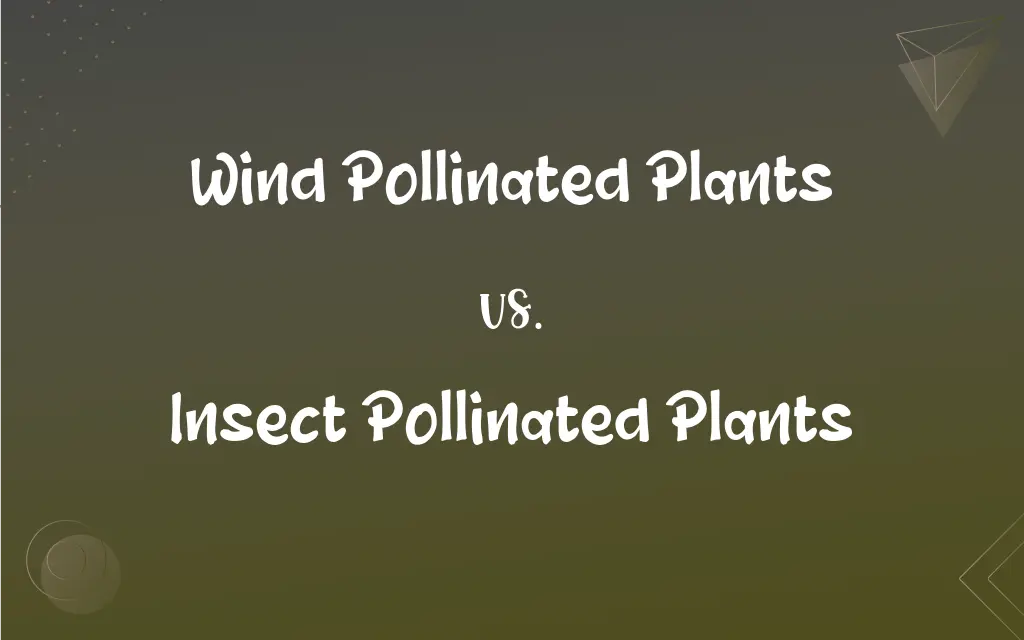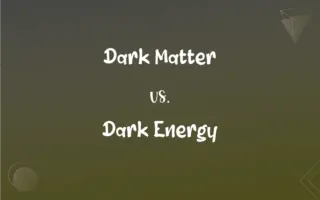Wind Pollinated Plants vs. Insect Pollinated Plants: What's the Difference?
Edited by Aimie Carlson || By Harlon Moss || Updated on October 6, 2023
Wind Pollinated Plants rely on wind for pollen transfer; Insect Pollinated Plants depend on insects for pollination.

Key Differences
Wind Pollinated Plants have evolved specifically to utilize the wind as their primary mechanism for the transfer of pollen from one flower to another. On the flip side, Insect Pollinated Plants have developed various adaptations to attract insects, which then facilitate the transfer of pollen between flowers.
The flowers of Wind Pollinated Plants usually lack vibrant colors and fragrances, as they don't need to attract insects. In contrast, the flowers of Insect Pollinated Plants often showcase bright colors, tantalizing fragrances, and nectar to lure and reward their insect visitors.
Additionally, the pollen grains of Wind Pollinated Plants tend to be light and small, allowing them to be easily carried by the wind. Conversely, the pollen of Insect Pollinated Plants is typically sticky and heavy, enabling it to adhere to the bodies of insect pollinators.
The reliance on wind or insects not only affects the structure and appearance of the flowers but also influences where these plants are best suited to grow. Wind Pollinated Plants can thrive in areas where insect populations might be sparse. However, Insect Pollinated Plants benefit from environments where there's a healthy diversity and abundance of insect life.
Comparison Chart
Pollination Mechanism
Wind
Insects
ADVERTISEMENT
Flower Characteristics
Dull-colored, non-fragrant
Brightly colored, fragrant
Pollen Texture
Light and small
Sticky and heavy
Presence of Nectar
Typically absent
Often present
Adaptation Purpose
To facilitate wind dispersal
To attract and reward insects
Wind Pollinated Plants and Insect Pollinated Plants Definitions
Wind Pollinated Plants
Plants with pollen designed for wind dispersal.
The pine tree releases clouds of pollen, characteristic of Wind Pollinated Plants.
ADVERTISEMENT
Insect Pollinated Plants
Flora often producing nectar as a reward.
Bees visit Insect Pollinated Plants like clover to collect nectar.
Wind Pollinated Plants
Flora that doesn't typically produce nectar.
Unlike many flowering plants, Wind Pollinated Plants like oaks don't offer nectar.
Insect Pollinated Plants
Plants that attract insects for pollen transfer.
Roses are Insect Pollinated Plants that allure bees with their scent.
Wind Pollinated Plants
Often lack vibrant flower colors.
The subtle hues of the barley flower are indicative of Wind Pollinated Plants.
Insect Pollinated Plants
Plants with sticky pollen to adhere to insects.
The sunflower, an Insect Pollinated Plant, has pollen that sticks to visiting bees.
Wind Pollinated Plants
Plants that utilize wind for pollen distribution.
Grasses are typical examples of Wind Pollinated Plants.
Insect Pollinated Plants
Flora utilizing insects for reproductive success.
Butterflies are frequently seen on Insect Pollinated Plants like marigolds.
Wind Pollinated Plants
Flora relying on airborne pollen transfer.
Corn is among the many Wind Pollinated Plants in agriculture.
Insect Pollinated Plants
Typically exhibit bright flower colors.
The vivid colors of lilies, as Insect Pollinated Plants, attract various pollinators.
FAQs
Is the pollen of Wind Pollinated Plants usually heavy?
No, it's generally light and small to be carried by the wind.
Do Insect Pollinated Plants always have nectar?
While many do, not all Insect Pollinated Plants produce nectar.
Do Wind Pollinated Plants typically have bright flowers?
No, Wind Pollinated Plants usually have dull-colored flowers.
How do Insect Pollinated Plants benefit insects?
They often provide nectar and pollen as food sources.
Why don't Wind Pollinated Plants have intricate flower structures?
Complex structures aren't needed since they don't need to attract or guide insects.
Are Insect Pollinated Plants found in all ecosystems?
They're widespread but more prevalent where insect diversity and numbers are high.
Why are the flowers of Insect Pollinated Plants often colorful?
The bright colors attract insects for pollination.
Are all grasses Wind Pollinated Plants?
Most grasses are wind-pollinated, but there can be exceptions.
Which type of plant might be more prevalent in a windy, arid region?
Wind Pollinated Plants would likely be more prevalent.
Is it essential for Wind Pollinated Plants to be near each other?
Yes, proximity increases the chances of successful pollination.
Can a plant be both wind and insect-pollinated?
While some plants can utilize both methods, most specialize in one.
Are all brightly colored flowers from Insect Pollinated Plants?
While many are, color alone isn't a definitive indicator.
Which is more efficient: wind or insect pollination?
Both have advantages; insect pollination is often more targeted, but wind can cover large areas.
Can human activities impact Insect Pollinated Plants?
Yes, factors like pesticide use can harm pollinators and affect these plants.
Do Insect Pollinated Plants rely solely on bees?
No, while bees are vital, other insects like butterflies, moths, and beetles also pollinate.
Is climate change impacting Insect Pollinated Plants?
Yes, changes in insect behavior and distribution can affect the pollination of these plants.
Why is the pollen of Insect Pollinated Plants sticky?
To adhere to the bodies of insect pollinators.
How can one encourage Insect Pollinated Plants in gardens?
Planting a variety of colorful, nectar-rich flowers can attract more insects.
Do Wind Pollinated Plants produce fragrance?
Typically, they don't since they don't need to attract insects.
Do Wind Pollinated Plants have larger pollen grains?
No, their pollen is typically smaller and lighter.
About Author
Written by
Harlon MossHarlon is a seasoned quality moderator and accomplished content writer for Difference Wiki. An alumnus of the prestigious University of California, he earned his degree in Computer Science. Leveraging his academic background, Harlon brings a meticulous and informed perspective to his work, ensuring content accuracy and excellence.
Edited by
Aimie CarlsonAimie Carlson, holding a master's degree in English literature, is a fervent English language enthusiast. She lends her writing talents to Difference Wiki, a prominent website that specializes in comparisons, offering readers insightful analyses that both captivate and inform.































































